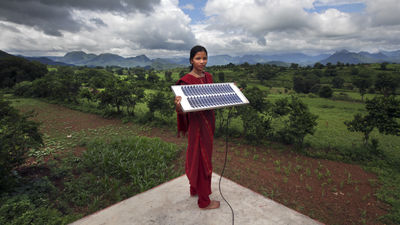What are the four stages involved in the development of renewable energy generation systems?

Electric power is indispensable to the progress of human life and civilization, but the method of power generation using fossil fuels such as coal and oil is concerned as a cause of global warming. Therefore, in recent years power generation methods using renewable energy, such as solar power generation and wind power generation, have been developed, and we are expecting to replace power generation using fossil fuels. American engineer and science fiction writer
The Third Phase of Clean Energy Will Be the Most Disruptive Yet-Ramez Naam
http://rameznaam.com/2019/04/02/the-third-phase-of-clean-energy-will-be-the-most-disruptive-yet/
According to Naam, there are about four stages where humans work to combat global warming through renewable energy generation. As the technology and scale of renewable energy develop, the stages will change, and the environment surrounding the whole will also change.
◆ 1: Stage promoted by policy
From the 1980s to around 2015, Naam believes that renewable energy was at the “policy driven stage”. Power generation using solar and wind power has become a reality, but oil and coal power generation is cheaper in cost, and renewable energy generation is in the red.
At this stage, nobody introduced renewable energy in search of profit, but was promoted by government subsidies working on environmental issues, and the growth of renewable energy was slow. During this stage, solar power generation accounted for 1% of the world's power generation, and wind power generation accounted for 4%, but hundreds of billions of dollars (several trillion yen) of funds were spent It seems that there is no progress.

◆ 2: Stage of competition with existing power generation methods
When renewable energy was promoted by policy, the expansion of renewable energy in the share of electricity generation methods was negligible. On the other hand, Naam points out that the most important progress made by the government in promoting renewable energy was the reduction in the cost of generating electricity from renewable energy.
With the efforts of the government and researchers since the 1980s, the cost of generating electricity from renewable energy has dropped rapidly, and the cost of generating electricity has dropped by a factor of 10 compared to the beginning. From around 2015, even if there is no government subsidy, it seems to be a time when the construction cost of solar and wind power generation facilities is lower than that of oil and coal power generation facilities.

by
◆ 3: Stages where renewable energy generation threatens fossil fuel generation
The low cost of renewable energy generation now threatens the existing fossil fuel power industry. Jim Robo, CEO of NextEra Energy, an electricity company that is promoting construction of solar and wind power facilities, said existing fossil fuel power generation facilities would be better for new solar and wind power generation facilities by the early 2020s. It is expected to be cheaper than operating.
Electricity supplier Florida Power and Light has announced that it will close its aging natural gas plant and build new solar power facilities and the world's largest electricity storage facility. The combination of solar power and batteries makes it possible to supply power even during the evening peak when power demand is high.
London's think tank, CarbonTracker , estimates that by the mid 2020s, construction costs for renewable energy generation facilities will be lower in the US, China and India than the cost of operating existing fossil fuel generation facilities . According to Naam, the transition from phase 2 to phase 3 in renewable energy generation takes place more quickly than from phase 1 to phase 2. At the second stage, renewable power generation is as competitive as existing fossil fuel power generation, and progress in the competitive market is very fast, said Naam. You are

◆ 4: Stages of stagnating growth
After the third phase, it is a renewable energy generation that seems to only spread around the world, but Naam points out that renewable energy generation may face a challenge in the future. Problems such as exhaustion of locations suitable for power generation, seasonal fluctuations in power generation, and lack of efficient storage of energy may temporarily counterwind renewable energy.
However, these problems are likely to grow in the very distant future, and Naam believes that solar power accounts for 20-30% of the world's power generation and wind power exceeds 40%. You are At the time of writing, solar power accounted for about 2% of the world's power generation, wind power about 6%, and it will take a considerable amount of time to reach the fourth stage. That's why Naam believes that it is unlikely that a solution will be created before the problem emerges.

Related Posts:
in Note, Posted by log1h_ik







